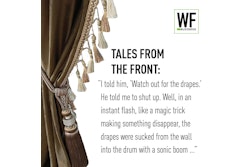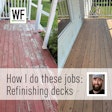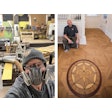I find it either ironic or appropriate that the flooring industry's annual show is held in Las Vegas. Flooring dealers and contractors love to gamble. They enjoy the thrill of taking risks in search of rewards. In Vegas, they risk a small amount of money in the hope of gaining a huge return. However, in their day-to-day business, they risk an enormous amount of money just to gain a very small return. You don't believe me? Well, as someone who has been in the flooring industry for over 20 years and has been a flooring inspector for 15 of those years, I have looked at thousands of problem floors. Too often the cause of the problem is a dealer or installer willing to take a risk that he knows he shouldn't but he thinks he'll get away with. Let's take a look at a typical example I've seen with mindnumbing frequency over the years. The names have been changed to protect the guilty; the results come straight from my files.
A Typical Gamble
Our typical flooring contractor, let's call him Joe, sells 1,500 square feet of glue-down prefinished engineered plank. Here in Florida, about 80 percent of the wood floors being installed are prefinished engineered wood glued to a concrete slab. This particular product is a 5-by-½-inch glossy, clear, natural maple he buys for $6 per square foot and sells for $10 per square foot. Joe sells his labor for $3 per square foot and pays the installer $2.50 per square foot. He buys five pails of urethane adhesive at $140 each and passes that cost straight to the consumer without markup. Lastly, he buys the appropriate trims (T-moldings, reducers, etc.) for $120 and sells them for $200. The total sale is $20,400, and Joe makes $6,830, a 33.5% profit. A job well-priced, well-sold, and hopefully well-done.
Certainly it's worth the risk. I mean, what could possibly go wrong?
Joe, however, is a gambler. If he uses only four buckets of adhesive, he'll make an extra $140, increasing his profit to $6,970. Joe and the missus can get a good meal at a great restaurant for $140. Certainly it's worth the risk. I mean, what could possibly go wrong?
Well, hollow spots start developing immediately after installation, and within three months there are 111 hollow areas varying in size from 18 inches in diameter to 3 by 4 feet. The planks are flexing up and down and making popping sounds. The "lippage" created by the flexing is causing abnormal wear along the edges. Joe tries to inject adhesive under a couple of planks, but he can't hide the plugged holes in the glossy maple. The customer stops Joe after this injection attempt because she didn't contract for a "polka-dotted floor." The consumer hires an independent inspector who removes planks in several areas. This reveals insufficient adhesive on the concrete, the wrong trowel-notch size, and little-to-no adhesive transfer to the back of the planks.
The True Risk
The consumer starts leaning hard on Joe. She threatens legal action, which is easy because her husband is a lawyer. Joe's only option at this point is to replace the floor. So how much is this going to cost him? Or, to put it another way, how much money did Joe risk to gain the princely sum of $140? $700? $6,970? $10,000? Not even close.
First, Joe has to buy more materials. He has the same material costs as before: $9,000 for the wood, $700 for adhesive and $120 for trims. In my neck of the woods, the labor charge for taking up wood flooring is the same for putting it down. So labor for replacing the floor is $5 per square foot, or $7,500, for a total of $17,320. But wait, there's more! The tear-up, floor prep and installation of the replacement floor are going to take at least twice as long as the original install. Joe is not going to be making any profit dollars from this crew until they're done redoing this failed job. He will have to postpone the profitable jobs. This translates into a loss of profit of $13,660 (2 x $6,830) for a grand total loss of $30,980.
Let's put that number in perspective. If Joe normally averages 33.5 percent profit on his jobs, then he will have to sell and install $92,477.61 worth of work before he can even buy groceries. That's almost five similar 1,500-square-foot jobs. Joe has thrown away almost $31,000 to gain $140.
It Could Be Even Worse
To make matters worse, the example I gave you is the best-case scenario. I didn't include freight, floor prep or moving furniture. What if there's piano-moving or a pool table take-down and setup? And, if Joe's margins are slimmer than in my example, the whole situation goes further south in a hurry.
The point is this: The risks aren't worth the rewards. The risks don't have to be the exact same ones in this example—I see similar things all the time, from contractors only nailing every other row to not using the right moisture retarder—but the results are the same. You have always heard that it is cheaper to do it right the first time than to do it over. I hope I have shown you how much cheaper.































